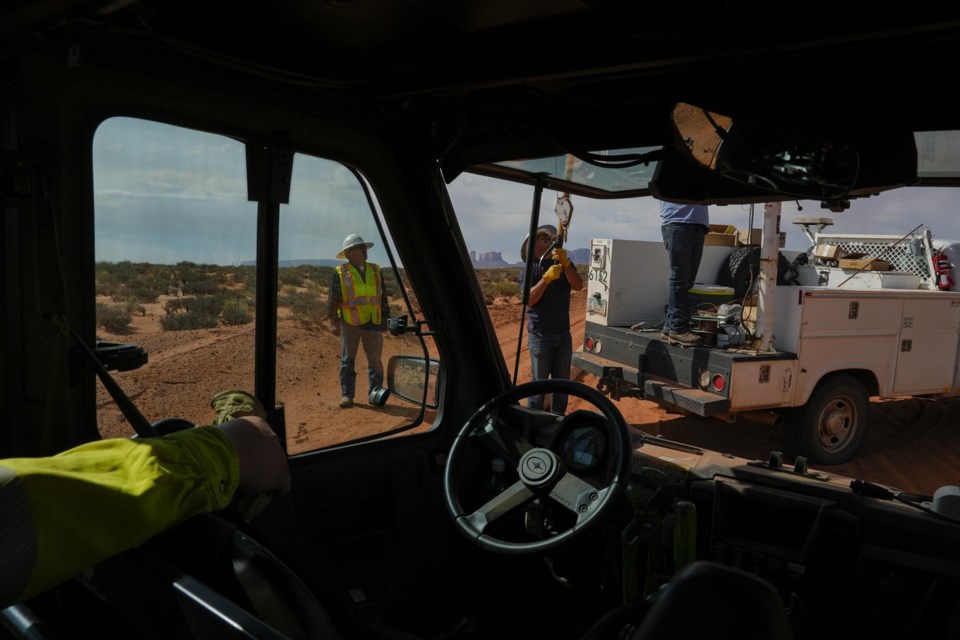HALCHITA, Utah (AP) — After a five-year wait, Lorraine Black and Ricky Gillis heard the rumblings of an electrical crew reach their home on the sprawling Navajo Nation.
In five days' time, their home would be connected to the power grid, replacing their reliance on a few solar panels and propane lanterns. No longer would the CPAP machine Gillis uses for sleep apnea or his home heart monitor transmitting information to doctors 400 miles away face interruptions due to intermittent power. It also means Black and Gillis can now use more than a few appliances — such as a fridge, a TV, and an evaporative cooling unit — at the same time.
“We’re one of the luckiest people who get to get electric,” Gillis said.
Many Navajo families still live without running water and electricity, a product of historic neglect and the struggle to get services to far-flung homes on the 27,000-square-mile (70,000-square-kilometer) Native American reservation that lies in parts of Arizona, New Mexico and Utah. Some rely on solar panels or generators, which can be patchy, and others have no electricity whatsoever.
Gillis and Black filed an application to connect their home back in 2019. But when the coronavirus pandemic started ravaging the tribe and everything besides essential services was shut down on the reservation, it further stalled the process.
Their wait highlights the persistent challenges in electrifying every Navajo home, even with recent injections of federal money for tribal infrastructure and services and as extreme heat in the Southwest intensified by climate change adds to the urgency.
______
EDITOR’S NOTE: This is part of a series of on how tribes and Indigenous communities are coping with and combating climate change.
______
“We are a part of America that a lot of the time feels kind of left out,” said Vircynthia Charley, district manager at the Navajo Tribal Utility Authority, a non-for-profit utility that provides electric, water, wastewater, natural gas and solar energy services.
For years, the Navajo Tribal Utility Authority has worked to get more Navajo homes connected to the grid faster. Under a program called Light Up Navajo, which uses a mix of private and public funding, outside utilities from across the U.S. send electric crews to help connect homes and extend power lines.
But installing power on the reservation roughly the size of West Virginia is time-consuming and expensive due to its rugged geography and the vast distances between homes. Drilling for power poles there can take several hours because of underground rock deposits while some homes near Monument Valley must have power lines installed underground to meet strict regulations around development in the area.
About 32% of Navajo homes still have no electricity. Connecting the remaining 10,400 homes on the reservation would cost $416 million, said Deenise Becenti, government and public affairs manager at the utility.
This year, Light Up Navajo connected 170 more families to the grid. Since the program started in 2019, 882 Navajo families have had their homes electrified. If the program stays funded, Becenti said it could take another 26 years to connect every home on the reservation.
Those that get connected immediately reap the benefits.
Until this month, Black and Gillis' solar panels that the utility installed a few years ago would last about two to three days before their battery drained in cloudy weather. It would take another two days to recharge.
“You had to really watch the watts and whatever you’re using on a cloudy day,” Gillis said.
Then a volunteer power crew from Colorado helped install 14 power poles while the tribal utility authority drilled holes six feet deep in which the poles would sit. The crew then ran a wire about a mile down a red sand road from the main power line to the couple's home.
“The lights are brighter,” Black remarked after her home was connected.
In recent years, significantly more federal money has been allocated for tribes to improve infrastructure on reservations, including $32 billion from the American Rescue Plan Act of 2021 — of which Navajo Nation received $112 million for electric connections. The Navajo tribal utility also received $17 million through the Biden administration's climate law, known as the Inflation Reduction Act, to connect families to the electric grid. But it can be slow to see the effects of that money on the ground due to bureaucracy and logistics.
Next spring, the tribal utility authority hopes to connect another 150 homes, including the home of Priscilla and Leo Dan.
For the couple, having grid electricity at their home near Navajo Mountain in Arizona would end a nearly 12 year wait. They currently live in a recreational vehicle elsewhere closer to their jobs, but have worked on their home on the reservation for years. With power there, they could spend more time where Priscilla grew up and where her dad still lives.
It would make life simpler, Priscilla said. “Because otherwise, everything, it seems like, takes twice as long to do.”
___
Naishadham reported from Washington.
___
The Associated Press’ climate and environmental coverage receives financial support from multiple private foundations. AP is solely responsible for all content. Find AP’s standards for working with philanthropies, a list of supporters and funded coverage areas at AP.org.
Joshua A. Bickel And Suman Naishadham, The Associated Press


